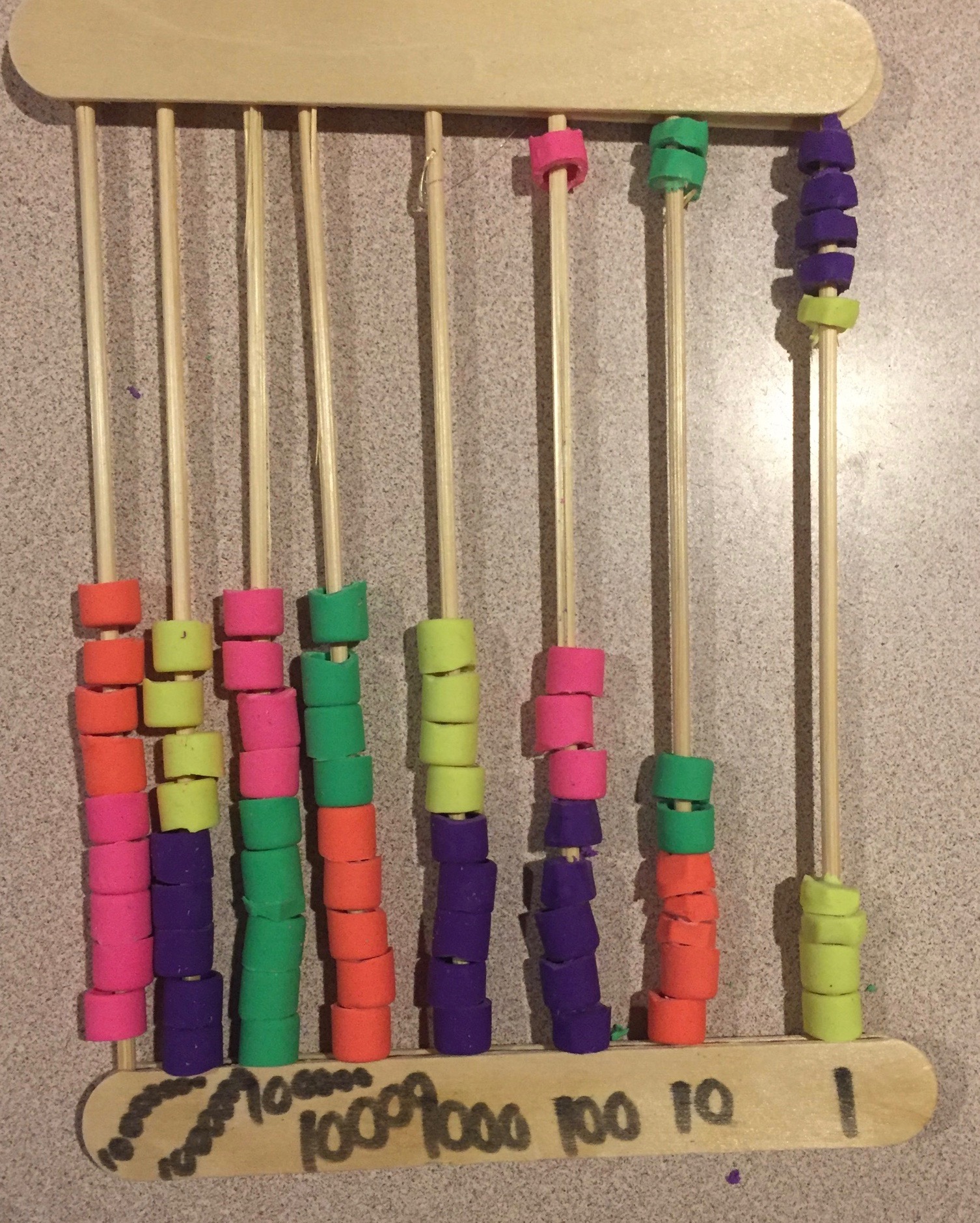Addition and Subtraction with an Abacus (Investigation)

The abacus was created to aid in addition, subtraction, multiplication, and division in a time when pen and paper were not readily available to everyone. This tool enables its user to quickly and easily solve math problems even when dealing with very large numbers. In this investigation you will make an abacus and explore how to use it to solve math problems.
Essential questions
- What is an abacus, and how can it be used to add and subtract large numbers?
- What other simple tools can you create that do a similar job?
Building an abacus
Materials
8 thin skewers (if yours are longer you can cut them down)
4 popsicle sticks
wood glue or hot glue gun
72 plastic beads (different colours, if possible)
pencil
Steps
Here are instructions to build one type of abacus. Of course, there are many other kinds as well. Use these instructions or do some research to find and explore other types.
- Lay one of the popsicle sticks on the table.
- Mark out 8 lines evenly spaced on the popsicle stick with a pencil.
- Put a thin line of wood glue on each of the lines, and place the skewers on top of the glue.
- Place more glue on top of the skewers.
- Lay another popsicle stick on top of the skewers so they are sandwiched between the two popsicles.
- Before glueing the other side, put 9 beads on each skewer. If possible, the first 5 should be one colour, and the second 4 should be a different colour.

- Place a thin line of glue on the another popsicle stick and place the beaded skewers on top of it.
- Place a little more glue on the ends of the skewers and place another popsicle stick directly over the other one so the skewers are sandwiched between them.
- If using wood glue place a heavy book gently on top of the abacus and let it dry for at least 20-30 minutes. If are using a hot glue gun, it should be dry and ready to go immediately after construction.

Optional: Write in the place value of each row.
Understanding how an abacus works
- Each row represents a different place value in the same order we have learnt for numbers. This means each of the beads in the far right row are worth 1, each of the beads in the row just to the left of that are worth 10, and so on.
- Beads are counted when they are pushed to the top of the abacus.
- To represent a number, move over the number of beads that represent the amount in each place value that number has. For example, the number125 would look like this picture. Notice 1 bead in the hundreds, 2 beads in the tens place, and 5 beads in the units (ones) place.

Adding numbers together
To add two numbers together, add each of the place values separately, starting from the right. For example, to add 25 to 125, we begin by moving up 5 beads in the row farthest to the right. We are one bead short, so we need to move all the beads down and exchange them for moving one bead up in the tens column. Next, move to the tens column. We move two beads up since 25 has 2 in the tens place. Once we have finished moving the beads, we count the new number of beads at the top and this is our new number.
Subtracting one number from another
This is done in very much the same way. If we wanted to subtract 20 from 125 we would begin with 125 on the abacus. Next, we start at the far right. We don't move any beads, because we have a 0 in the units place of our number, 20. Moving left to the tens place, we move two beads down, since 20 has a 2 in the tens place. Now we count the new number of beads at the top and this the answer.
Time to use the abacus
Try doing some addition and subtraction with your abacus. Pay attention to the similarities it has to other addition and subtraction strategies you have used. Start with these problems, or make up and answer your own.
- 30 + 40
- 67 + 92
- 48 + 5
- 29 + 5
- 17 + 34
- 242 + 602 + 70
- 72 + 903 + 457
- 100 - 20
- 87 - 27
- 79 - 15
- 31 - 23
- 867 - 311
- 300 - 180 - 10
- 30 - 7 - 5
- How is addition and subtraction with an abacus similar to other addition and subtraction strategies we have learnt? How is it different?
- Some people actually use their hands as an abacus to add and subtract quickly. How might they might do this?
- Create another concept for an abacus, or find a way to improve the tool to multiply and divide.